During the period that I came into the picture, I sustained a serious knee injury during the pre-season. The patellar tendon was torn from the bone. This included surgery and nine months of rehabilitation. When I finally got back in, a muscle tear followed. A lost year. Anderlecht wanted to put me in the U19 for another season. I didn't like that.
The above quote, from Alessio Castro-Montes in an interview with Voetbal Belgie in 2019, is just a glimpse into what his character is like, and by extension, the type of player he is. As a right-back, it is not always easy to put your stamp on a game, but Castro-Montes knows what he wants and what he is capable of.
To come back from successive injuries at the age of 18 and still demand minutes in the senior squad of one of the country's biggest clubs takes tremendous heart and mental fortitude.
This piece is still mainly based on cold, hard statistics and tactical analysis. But it would be impossible to build a player profile without mentioning the human aspect of this youngster's development as a footballer.
Castro-Montes was born in Sint-Truiden, Belgium, to a Spanish father and Belgian mother and spent time in the academies of 3 different Pro League clubs (Standard Liege, RSC Anderlecht and Sint-Truidense). He finally broke into the senior team for his hometown club.
However, soon after his debut, he was relegated to the youth team once again by manager Ivan Leko, leading him to find a new home at KAS Eupen. He spent two years with the Pandas before moving to KAA Gent at the start of this season.
He has impressed many in Belgium with his consistent, high-energy performances and has started to attract interest from several bigger European clubs as well. In this article, we will analyse his playing style and technical ability in the 3 main categories that full-backs are meant to excel in: defence, ball progression and final third contribution.
Alessio Castro-Montes' Defensive Capability
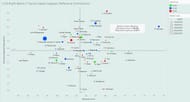
In the above chart, right-backs under the age of 25 in Europe's top 5 leagues, along with the top divisions of Belgium, Switzerland, Portugal and the Netherlands have been compared using 2 metrics; the percentage of defensive duels won on the x-axis and the number of interceptions per game (adjusted for possession) on the y-axis.
Essentially, it should give us a decent measure of their ability to succeed when they are engaged defensively, as well as how good they are at predicting opposition moves.
In this sense, Castro-Montes appears on the border between the first and fourth quadrants, showing that he is above average at winning his defensive duels (with 64.69% won) and about average for the number of opposition passes he cuts out, at 6.2.
However, merely looking at the numbers is not enough. To get a comprehensive report, we need to find out how he achieves this level of performance.
Castro-Montes is a fairly small man, measuring in at 178 cm and weighing just 74 kg, not ideal for a pure defender but not necessarily a bad thing for a full-back. Due to his size (or lack thereof), he is able to get away with slightly more physical contact than someone bigger than him would be able to. He likes to get touch-tight to his man when defending and often stays in close physical contact, waiting and probing until he can pounce.
He is probably not suited to playing in a team which employs a low block, as he has the tendency to rush out of the defensive line to press and harry opponents. This is something he does well thanks to his considerable speed, which is also a reason he puts up good interception numbers.
Castro-Montes often intercepts long, lateral opponent passes by rushing back and clearing them before they reach the intended target. However, there is no reason to think that that is the extent of his predictive ability. He is capable of reading opponents' minds and assessing the game situation, as the following images will show.
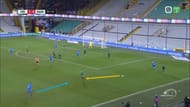
Here, Gent (in blue) are playing against Cercle Brugge and have just ventured forwards, only for the attack to break down and for their opponents to emerge with the ball. Here, the pass has been played by the Brugge left-back into midfield (the yellow arrow) and Castro-Montes has stepped out to press the ball receiver (the blue arrow).
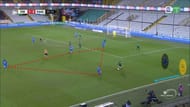
In this frame, the Brugge player in midfield has received the ball and now needs to move his team upfield. However, his hopes of moving into the centre have effectively been cut off by the 4 Gent players (joined by the perforated red lines).
Also, we see that closer to the touchline, the Brugge left-back (highlighted in yellow) has just started to accelerate, even as the Gent winger (in black) starts to slow down, therefore not tracking his opponent's run (the blue arrow).
Remember, Castro-Montes needs to take in and process all this information, which he is able to do on his way out to press.
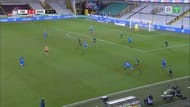
Given that he is now armed with all the information that his opponent has, he realises what he has to do. As the Brugge midfielder shifts towards his right, Castro-Montes feints to move along with him, whilst simultaneously stretching his right leg out.
Sure enough, his opponent looks for the reverse pass to the flank, which is cut out, enabling Gent to push forward once more, this time with Brugge being less structured at the back.
What this goes to show is that Castro-Montes is more than capable of reading the game, and getting into the mind of his opponent to execute smart pieces of play which end up proving extremely beneficial to his side.
Progression
In addition to being solid at the back, another important duty of the full-back in most modern teams (depending on their system, of course) is to progress the ball, from point A to point B- A usually being their defensive third and B usually being the midfield or, if possible, the attacking third.
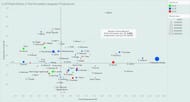
This chart measures the progressive ability of the aforementioned batch of right-backs, by plotting their number of passes into the final third of the pitch against the progressive runs per game. This is defined by Wyscout as 'a player carrying the ball towards the opponents' goal over 30 metres in their own half, 15 metres between halves or 10 metres within the opponents' half'.
Here, Castro-Montes places firmly in the first quadrant, which consists of players that are above average at both passing the ball into the final third, as well as making significant headway by carrying it themselves. Watching him also backs up the theory that ball progression and chance creation are quite possibly his biggest strengths.
One aspect of his game that is instantly noticeable is that he doesn't hesitate. Once he has decided to dribble, he sticks by it without second-guessing himself. If he decides to pass, he goes for it. He also knows instinctively, when dribbling, whether to stop, and pick a pass or to keep going, an invaluable skill which some players senior to him have still not mastered.
Interestingly, he does not play forward passes in the traditional way a right-back would, by playing the ball into space down the line. Instead, he chooses to cut inside, taking the ball onto his left foot before playing a ball through to the striker making a run in behind the centre-backs, as is illustrated below.
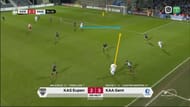
This tendency of his allows Castro-Montes to serve as a credible player to attack the half-spaces (between the opposition full-back and centre-back), making him a playmaker from out wide, a la Trent Alexander-Arnold at Liverpool, albeit in a different way.
His ability to consistently complete these passes is perhaps a consequence of him playing as a midfielder in his youth team days (where he was considered to be at par with Youri Tielemans).
Now, showcasing those skills from right-back makes him a dangerous proposition for opposition players and managers.
Final Third Impact
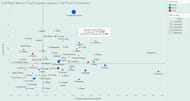
Here, we get a measure of the players' contribution to attacking moves in the final third. By plotting the number of crosses attempted against the number of touches they take in the opposition penalty area, we can get a fair idea of how, as well as how much, they are involved in the final phase of the attack.
With 4.7 crosses and 1.2 touches in the opposition box per 90 minutes, Castro-Montes is among the most involved full-backs in Europe, in an attacking sense. These numbers also suggest that he is more of a provider from out wide, as only 7 players attempt more crosses than he does.
This is borne out well by watching him. When a teammate is in possession, he tends to drift out wide and towards the byline, to ensure he is in the best possible position to cross the ball quickly. When crossing from deep, he generally floats the ball in towards the far post, giving his attackers time to position themselves better. When crossing from close to the byline, he drills it in, looking to cause confusion amongst the defence.
However, on the ball, he cuts inside, on to his left foot, a behaviour we have already seen in his playmaking. This is not limited to him simply trying to pass, as he often comes inside and shoots, trying to curl the ball into the far corner with his left. If the opportunity arises, he also goes for power when he shoots with his right foot.
Conclusion
Given that he signed a 3-year deal upon joining Gent, it seems that Castro-Montes would be looking to move to a bigger club sooner rather than later. If Spurs want him, they would probably need to move fast, given that Sevilla are rumoured to be interested, to the tune of around €10 million.
Still only 23 years old, he would be a solid pick-up for any team in the Premier League, given the relative value for money. This is all the more important now thanks to the pandemic, and his skill-set would suit the English top-flight nicely.
For Tottenham in particular, he would provide a more reassuring defensive presence than current right-back Serge Aurier, without compromising on the attacking side. This perhaps makes him the ideal target for the position this summer.
(Note: All statistics and match images taken from Wyscout.)
